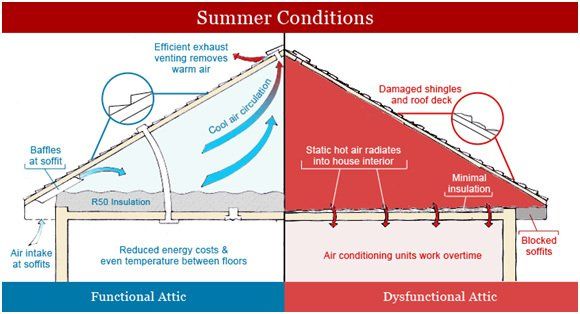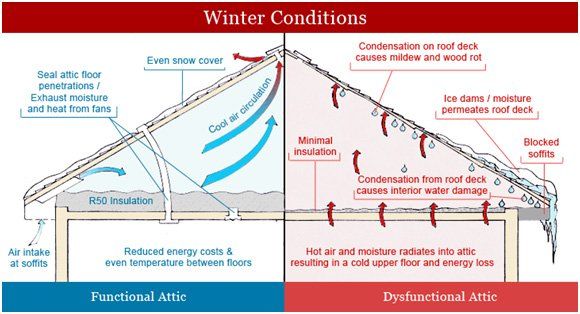

Perfection Roofing Family
"We Care About You"
Oklahoma CIB Registration #80005587
Ventilation
Residential Home Ventilation
Proper attic ventilation extends the life of a roof by minimizing the temperature differential between the attic and the air outside. Proper ventilation will remove heat and moisture from your home. Trapped heat and moisture can raise energy costs, allow ice to build up, and damage your roof. Moisture can come from both outside your home, and inside from items like showers and washing machines. In some cases the condensation can be bad enough to be mistaken for a roof leak.
Here are some problems associated with an improperly ventilated attic space:
- Sumps between rafters (deck deflection) can happen because after awhile (sometimes several years, sometimes only a couple years), a plywood roof deck can warp or deteriorate and become spongy and dangerous to walk on.
- Water vapor will condense on anything metal in an attic. This can cause the metal to rust.
- In colder climates, high inside humidity combined with low outside temperatures can cause frost to form on the roof deck.
- Ice Dams – ice dams are the result of melting snow refreezing at the roof perimeter and then backing up under the shingles and causing leaks. Proper ventilation used in conjunction with heavy insulation and an air barrier can create a Cold Roof Assembly which will help eliminate ice dams.
- The roof system will deteriorate prematurely.
- Cooling units will need to be serviced or replaced prematurely because of excessive use.
It is estimated that most homes in North America do not have adequate ventilation. Most people don’t understand the long term effects this can have on their entire house. Proper attic ventilation is important to avoid moisture buildup and aid in temperature control.
Additional damage resulting from an improperly ventilated attic:
1. Premature aging of your roofing system.
2. Damage to your siding, paint, and wallpaper
3. Higher energy costs resulting from warm or cold air exchanging between the attic and the living space.
4. Ice dams caused by warm air in the attic space melting the bottom layer of snow on the roof and refreezing at the gutter. This buildup of ice traps additional melting snow causing it to pressurize and back up under the roofing system and into your home.
5. Mildew and mold growth.
6. Buckling or curling shingles and felt.
Proper attic ventilation allows constant air flow into the attic. This creates a balance between air intake at your eaves or soffits and air exhaust at the roof’s ridge.
The Federal Housing Administration (FHA) recommends a minimum of at least 1 square foot of attic ventilation, both intake and exhaust, for every 300 square feet of attic floor space.
Aside from having proper ventilation, it is also a good idea to make sure your attic has sufficient insulation. This will help regulate your home’s internal temperature. Having sufficient ventilation and insulation are vital for keeping your house warm in the winter and cool in the summer. It is important to make sure any ventilation issues are addressed and corrected in order to eliminate any future problems when you prepare to replace or repair your roof.
Schedule a Free Roof Inspection Today!
918-665-6747
Contact Us Today!
We will get back to you as soon as possible.
Please try again later.
Serving Tulsa & Surrounding Areas
5507 E 61st Pl, Tulsa OK 74136
jerry@perfectionroofinginc.com
brandi@perfectionroofinginc.com
Oklahoma CIB Registration #80005587
All Rights Reserved | Perfection Roofing
Find us on:




